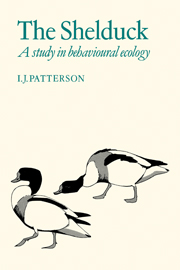Book contents
- Frontmatter
- Contents
- Acknowledgments
- 1 Introduction
- 2 The shelduck
- 3 Gregariousness: the winter flock
- 4 Territories
- 5 Prospecting for nest sites
- 6 Laying and incubation
- 7 Care of the young
- 8 Duckling survival
- 9 Recruitment and the non-territorial flock
- 10 The limitation of shelduck populations
- References
- Subject index
- Author index
6 - Laying and incubation
Published online by Cambridge University Press: 04 August 2010
- Frontmatter
- Contents
- Acknowledgments
- 1 Introduction
- 2 The shelduck
- 3 Gregariousness: the winter flock
- 4 Territories
- 5 Prospecting for nest sites
- 6 Laying and incubation
- 7 Care of the young
- 8 Duckling survival
- 9 Recruitment and the non-territorial flock
- 10 The limitation of shelduck populations
- References
- Subject index
- Author index
Summary
Having selected a nest site, the breeding bird must build a nest, lay a clutch of eggs and incubate them. The number of young hatched will depend on the size of clutch which can be produced and success in hatching them, in the face of many factors which might cause failure. Incubating birds must divide their time between the eggs and the need to spend some time feeding, the balance depending on the fat reserves which can be lost over the incubation period. In this chapter I will discuss these and other problems encountered by laying and incubating shelducks.
The timing of laying
The date on which the first egg of the clutch is laid can only rarely be determined by direct observation during the egg-laying period, due to the inaccessibility of the nests and the birds' intolerance of disturbance. Instead, a number of indirect methods must be used. In a few nests, observed before laying is complete, the laying date of the first egg can be back-dated since normally one egg is laid per day (Hori, 1964a). If the hatching date and clutch size are known, the laying date can be estimated using the incubation period of 29–31 days (Hori, 1964a; Young, 1964a), plus one day for each egg in the clutch. More commonly the laying date is back-dated from the first sighting of the brood of ducklings, adding a further day which the young spend in the nest after hatching (mean of four nests observed at hatching by Young, 1964a).
- Type
- Chapter
- Information
- The ShelduckA Study in Behavioural Ecology, pp. 139 - 160Publisher: Cambridge University PressPrint publication year: 1982



